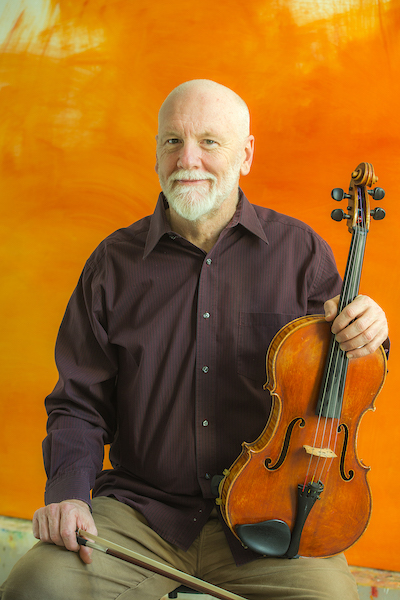Brett Dean premiere a signal achievement in CMS program

Brett Dean’s “Seven Signals” was given its world premiere by the Chamber Music Society of Lincoln Center Friday night. Photo: Bettina Stoess
There’s an old story, doubtless apocryphal, about Albert Einstein playing violin in a chamber-music evening with friends. It seems the great physicist kept getting out of sync with the others, until one of them asked exasperatedly, “Can’t you count?”
The Chamber Music Society of Lincoln Center has taken lately to giving its concerts overall titles, such as “Windstorm” or “Farewells.” Plainly stuck for what to call Friday’s program of Beethoven, Debussy, Brett Dean, and Brahms in Alice Tully Hall, the Society gave it the most generic title imaginable: “Three Centuries.”
Let’s see, respectively, that’s the 18th, the 20th, the 21st and the 19th.
Oh well, what’s one century more or less? On Friday night, five musicians of the Society showed that not only could they count, they could play microtones and multiphonics. They could give a piece a world premiere that will be hard for subsequent performances to match. And they could get inside the fundamentally different styles of (count ‘em) four composers and give colorful, compelling, and entirely appropriate performances of each.
The newsmaker of the evening was of course Dean’s Seven Signals for Clarinet, Violin, Cello and Piano, making its world bow as a co-commission of CMS and London’s Wigmore Hall, in an evocative performance by clarinetist Tommaso Lonquich, violinist Arnaud Sussmann, cellist Nicholas Canellakis and pianist Wu Qian.
In seven brief movements — tailored, in effect, to today’s shorter attention span — Dean’s piece sought to counteract another modern trend, the endless verbosity of our media. Instead of seeking inspiration in poetry, visual art or current events, the Australian composer turned for a subject to nonverbal communications, from distress signals at sea to scratches on a prison cell wall.
Using the most nonverbal of the arts to evoke the wordless side of life resulted in some surprisingly concrete imagery. Following a preludial “Impulse Study,” in which isolated sounds in space coalesced into furiously motoric music resembling klezmer and rock, “Beacon” proved a Debussyesque rendering of a flickering, intermittent light amid tendrils of fog.
“Morse 1” was even more specific, building a complex yet driving rhythm from the Morse-code distress calls of the RMS Titanic as it sank in April 1912.
Although the weightless feeling of “Body Language (Pas de deux)” was meant to evoke dance, the movement had an elegiac character as it pulled back from the terrible scene at sea; its euphonious triads with tangy dissonances, and soft piano chords like distant bells, recalled a composer contemporary contemporaneous with the Titanic, Charles Ives.
As evidenced by the tapping right foot of violinist Sussmann, a lot of counting was going on during the spasmodic gestures and long silences of “Semaphore,” which was among other things a virtuoso demonstration of an ensemble staying together through irregular rhythms with hardly any actual notes. At precisely timed moments, Sussmann and Canellakis whipped the air with their bows in semaphore-like gestures.
In “Tallying,” a steady pulse of repeated quarter notes symbolized the way long-term prisoners mark the passing days of their confinement with parallel scratches on the cell wall. A rhapsodic acceleration at mid-movement seemed like a brief vision of freedom.
The final movement, “Morse 2,” returned to the Titanic, where time was measured not in days and years but in seconds. As Qian reached inside the piano to tap out the distress signal softly on a damped string and the others played fragments of the hymn “Nearer My God to Thee,” the music dwindled to pianissimo, then flickered out with shocking suddenness.
Recovering from the piece’s dark ending, the audience showered the performers and the composer with applause, calling them back to the stage several times.
On its big night, Dean’s piece was surrounded by works of composers the Australian has cited as his models. Beethoven’s three string trios, Op. 9, composed in 1797-98, are not heaven-storming statements but convivial music to play at home, and this is especially true of the set’s shy middle child, No. 2 in D major.
For all their professional polish, rhythmic discipline, and insight into each movement’s shape and direction, Sussman, Canellakis and violist Yura Lee sustained the illusion that the audience wasn’t there, and they were playing solely for their own mutual enjoyment.
Debussy’s Première rapsodie for Clarinet and Piano, on the other hand, was composed in 1909-10 for an audience, and a very specific one: a panel of Paris Conservatoire professors and other notables (including Debussy himself) evaluating degree candidates in clarinet.
On Friday, clarinetist Lonquich passed the test with full, woody singing tone, droll asides, and brilliant gymnastics. But Debussy’s piece is truly a duo, and Qian could have mixed it up more with the clarinetist, instead of playing as if it was somebody else’s audition.
Following these three works and an intermission, Brahms’s youthful Piano Quartet in G minor, Op. 25, composed in 1857-61, stood alone in the program’s second half, with a performance so enthralling that its nearly three-quarters of an hour seemed far too short.
The work’s sinewy first movement, fluid scherzo, fervent Andante con moto, and hilarious, heel-clicking gypsy finale had the audience in raptures at the end. Sussman, Canellakis and Lee all played with distinction, but top honors must go to Qian, whose rich Brahmsian piano tone, superb chord voicing, and blazing technique lifted the entire performance, engaging her colleagues without ever covering them. One would love to hear her in a Brahms concerto someday.
The Chamber Music Society of Lincoln Center will perform “George Crumb at 90: Part I” 5 p.m. April 14 and “George Crumb at 90: Part II” 7:30 p.m. April 16, both at Alice Tully Hall. chambermusicsociety.org; 212-875-5788.